Minding the Output Gap: What Is Potential GDP and Why Does It Matter?
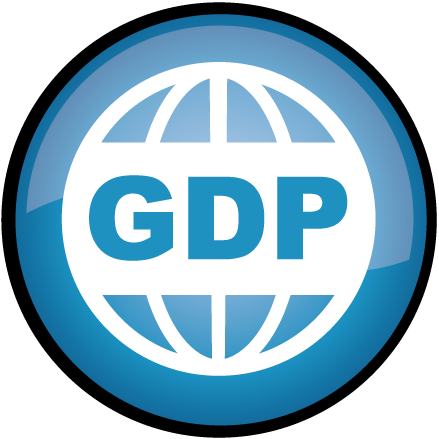
"Is real output greater or less than potential? And is real output growing more or less rapidly than potential? The answer to these questions are central to policy decisions."
—Richard G. Anderson, Economist1
Gross domestic product (GDP) is the total market value, expressed in dollars, of all final goods and services produced in an economy in a given year. GDP indicates the size of the economy by measuring the economy's output. It is also one of the key measures economists use to assess the health of the economy. For GDP to measure the "real" increase or decrease in output over time, however, the effect of price changes needs to be removed from the data. Real GDP does that: It controls for (takes out) inflation and more accurately reflects actual economic growth. But knowing the size of the economy, or its growth rate, only tells part of the story. For a more complete assessment of the economy's health, it is helpful to compare how much the economy is producing with how much it could be producing. Economists do this by comparing the economy's actual output (which real GDP tells us) with its potential output.
What Is Potential Output?
Potential output is an estimate of what an economy could feasibly produce when it fully employs its available economic resources. The Congressional Budget Office (CBO) estimates potential output by estimating potential GDP, which it describes as "the economy's maximum sustainable output."2 The word "sustainable" is important—it doesn't mean that the entire working-age population is working 18 hours per day or that factories are operating 24/7. Rather, it means that economic resources are fully employed—at normal levels. Potential output (estimated as real potential GDP) serves as an important benchmark level against which actual output (measured as real GDP) can be compared with at any given time. In short, economists use potential output to represent a normal—or benchmark—level of output against which actual output can be compared.3 Figure 1 shows estimates for real potential GDP extending 10 years into the future.
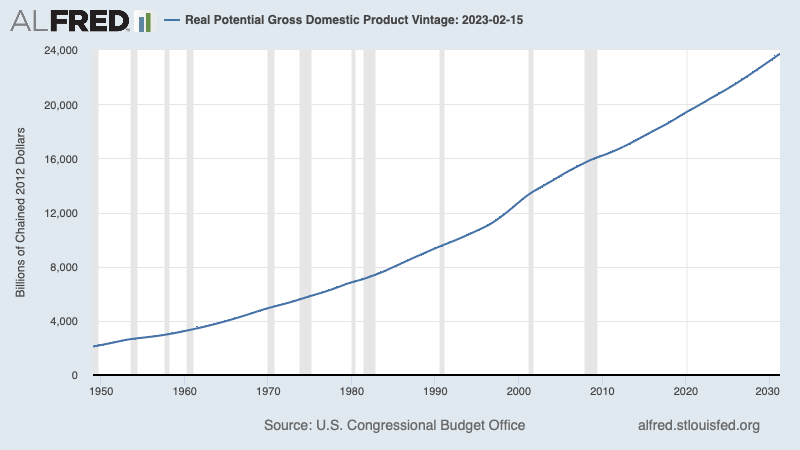
Figure 1
Real Potential GDP, 1949-2031
SOURCE: ALFRED®, Federal Reserve Bank of St. Louis; https://alfred.stlouisfed.org/graph/?g=18UG7#, accessed September 15, 2023.
Of course, there might be a difference between actual output and potential output. Although rare, it's possible for actual output to be higher than potential output. It is far more common, though, for actual output to be lower than potential output. The difference between actual output and potential output is called the output gap, which is expressed as a percentage of potential output (see the boxed insert). The short-run fluctuations of actual output around potential output determine the business cycle—economic expansions and contractions, or recessions.
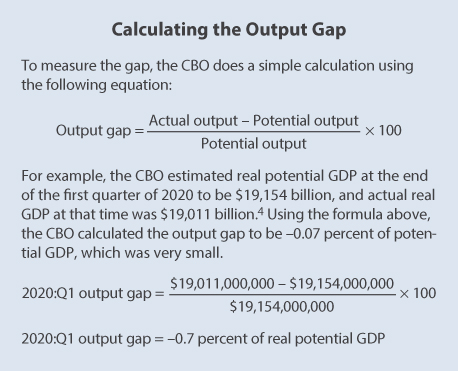
Minding the Output Gaps
A negative output gap occurs when actual output is below potential output. You can see negative output gaps on Figure 2: Look for where the red line (real GDP) is below the blue line (real potential GDP). When an economy is functioning below potential, it has a negative output gap and is underutilizing its resources. That is, many offices and factories might be closed or running below full capacity and the unemployment rate is most likely on the rise, indicating that the economy is below full employment. In business cycle terms, this usually means that the economy is in a recession. Notice on Figure 2 how recessions (shaded areas) correspond with negative output gaps (the red line drops below the blue line).
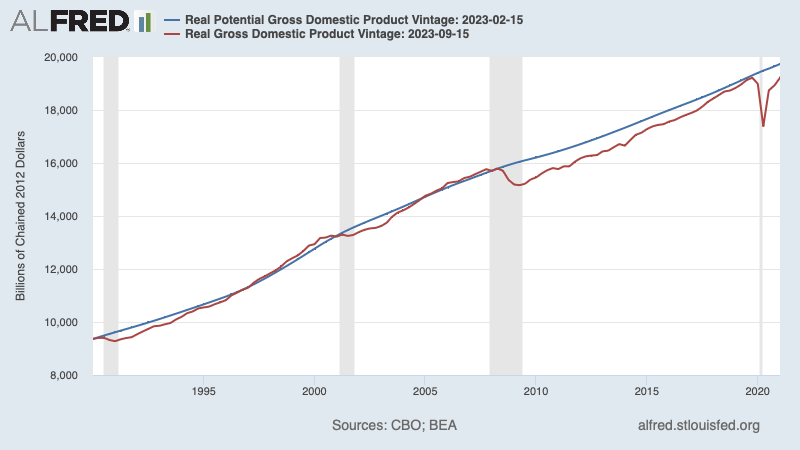
Figure 2
The Output Gap, 1990-2021
SOURCE: ALRED®, Federal Reserve Bank of St. Louis; https://alfred.stlouisfed.org/graph/?g=18UBn#, accessed September 15, 2023.
A positive output gap—when actual output is higher than potential output—occurs when the economy is "overachieving." While this might be feasible in the short run, it is rare and, ultimately, unsustainable over time. For example, think about the week or so before final exams. You might cancel your social activities, study late into the night, and then wake up early to study a little more. You might be able to keep such a schedule for a little while, but most people would likely find it unsustainable in the long run. For the economy, this might occur because workers are working extra shifts or production lines and machines are running without recommended downtime and maintenance. In business cycle terms this usually means that the economy is expanding. When this occurs, the unemployment rate is likely low and decreasing.
In short, a positive output gap occurs when actual output exceeds potential output, which means the economy is fully employed and overutilizing its resources. These positive output gaps can be seen in Figure 2 where the red line (real GDP) is above the blue line (real potential GDP). Although the economy can expand at a rate that exceeds its long run potential, that pace is unsustainable in the long run.

Figure 3
The Output Gap Expressed in Constant Prices, 1950-2021
SOURCE: ALFRED®, Federal Reserve Bank of St. Louis; https://alfred.stlouisfed.org/graph/?g=18UFu#, accessed September 15, 2023.

Figure 4
The Output Gap Expressed as a Percentage of Real Potential GDP, 1950-2020
NOTE: As the economy expands, the output gap narrows and (in most cases) becomes positive. As the economy contracts, the output gap expands and becomes negative. Graphically, the synchronization between the output gap becoming negative and the beginning of recessions is evident, but irregular.
SOURCE: ALFRED®, Federal Reserve Bank of St. Louis; https://alfred.stlouisfed.org/graph/?g=18UFD#, accessed September 15, 2023.
The deviations of actual output from potential output—that it, real GDP from real potential GDP—may seem fairly small (Figure 3). When they are expressed as a percentage of real potential GDP, however, the gaps become more apparent (Figure 4 ). Swings into negative territory can be very disruptive on people's live. For example, the negative output gap associated with the Great Recession of 2007-09 moved the unemployment rate from 4.4 percent shortly before the recession started to 10 percent in late 2009, and the recession that began in spring 2020 and is associated with the COVID-19 pandemic raised the unemployment rate from 3.5 percent to 14.8 percent. Unemployed people endure hardships such as having to live off of savings or going into debt to pay for expenses and possibly even losing homes and cars. They might also have difficulty finding a new job after prolonged unemployment.
Why Does Potential Output Matter?
Potential output is important because policymakers consider the output gap when determining whether the economy needs more or less stimulus.5 For example, when the economy is experiencing a negative output gap, the Federal Open Market Committee (FOMC) is likely to lower its target range for the federal funds rate to lower interest rates and ease financial conditions for consumers and businesses.6 When necessary, the FOMC might also use unconventional monetary policy tools such as large-scale asset purchases.7
Real potential GDP is of concern to some economists and policymakers because it uses past data to estimate the trend going forward—and estimates can be wrong. And if these estimates are flawed, then policy based on them may be flawed as well. For example, economist Athanasios Orphanides (in 20028 and 20039) argued that during the 1970s the Federal Reserve believed that potential output was higher than it actually was—and therefore that the output gap was more negative than it really was—and took overly simulative actions that contributed to the increased inflation of the 1970s.10
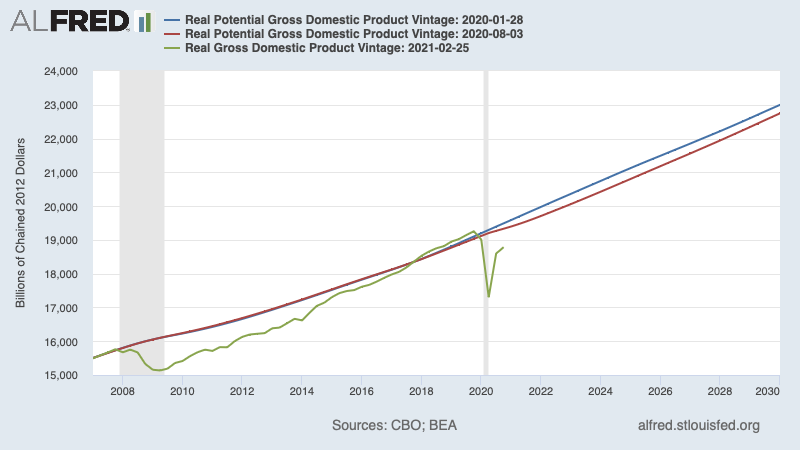
Figure 5
Real Potential GDP Data Revisions, 2007-2030
NOTE: The blue line shows the CBO's estimates of real potential GDP on January 28, 2020, which was before the COVID-19 pandemic affected the U.S. economy, while the red line shows them on August 3, 2020. The green line shows the most recent real GDP data.
SOURCE: ALFRED®, Federal Reserve Bank of St. Louis; https://alfred.stlouisfed.org/graph/?g=18UC2#, accessed September 15, 2023.
To account for changes in the economy that impact potential output, the CBO updates its projections on a regular basis. For example, Figure 5 shows the change in the estimations of real potential GDP from January 28, 2020 (blue line, before COVID-19 affected the U.S. economy), and August 3, 2020 (red line).
Conclusion
Potential output is estimated by the CBO as real potential GDP. Comparing real potential GDP to real GDP—that is, potential output to actual output—can provide useful information for how the economy is performing relative to its potential. Operating below potential indicates that an economy is underutilizing its resources: The output gap is negative and there is "slack" in the economy. On the other end, a positive output gap means that the slack has disappeared and resources are fully employed, or perhaps overutilized. In fact, monetary policymakers use the output gap to inform policy. As such, errors in the estimation of real potential GDP can reduce the effectiveness of policy.
Notes
1 Anderson, Richard. "Editor's Introduction." Federal Reserve Bank of St. Louis Review, July/August 2009, p. 181.
2 CBO. "Budget and Economic Data." https://www.cbo.gov/data/budget-economic-data#6, accessed March 10, 2021.
3 Marifian, Elise A. "The Output Gap: A 'Potentially' Unreliable Measure of Economic Health?" Page One Economics®, November 2012; https://research.stlouisfed.org/publications/page1-econ/2012/11/01/the-output-gap-a-potentially-unreliable-measure-of-economic-health.
4 CBO. "Budget and Economic Data." https://www.cbo.gov/about/products/budget-economic-data#4, accessed March 23, 2021.
5 Gavin, William T. "What Is Potential GDP and Why Does It Matter?" Economic Synopses, No. 11, 2012; https://doi.org/10.20955/es.2012.11.
6 For a full discussion of the way the Federal Reserve implements monetary policy, see the following: Ihrig, Jane and Wolla, Scott. "The Fed's New Monetary Policy Tools." Page One Economics®, August 2020; https://research.stlouisfed.org/publications/page1-econ/2020/08/03/the-feds-new-monetary-policy-tools.
7 For more information about large-scale asset purchases, see the following: Mendez-Carbajo, Diego. "Temporary Open Market Operations and Large-Scale Asset Purchases." Page One Economics®, Summer 2020; https://research.stlouisfed.org/publications/page1-econ/2020/07/01/temporary-open-market-operations-and-large-scale-asset-purchases.
8 Orphanides, Athanasios. "Monetary-Policy Rules and the Great Inflation." American Economic Review, May 2002, 92(2), pp. 115-20.
9 Orphanides, Athanasios. "The Quest for Prosperity Without Inflation." Journal of Monetary Economics, April 2003, 50(3), pp. 633-63.
10 For more information about unconventional monetary policy tools, see the following: Mendez-Carbajo, Diego. "Temporary Open Market Operations and Large-Scale Asset Purchases." Page One Economics®, Summer 2020; https://research.stlouisfed.org/publications/page1-econ/2020/07/01/temporary-open-market-operations-and-large-scale-asset-purchases.
© 2021, Federal Reserve Bank of St. Louis. The views expressed are those of the author(s) and do not necessarily reflect official positions of the Federal Reserve Bank of St. Louis or the Federal Reserve System.
Glossary
Actual output (real GDP): The amount that an economy actually produces, as measured by real GDP.
Business cycle: The fluctuating levels of economic activity in an economy over a period of time measured from the beginning of one recession to the beginning of the next.
Federal funds rate: The interest rate at which a depository institution lends funds that are immediately available to another depository institution overnight.
Federal Open Market Committee (FOMC): A Committee created by law that consists of the seven members of the Board of Governors; the president of the Federal Reserve Bank of New York; and, on a rotating basis, the presidents of four other Reserve Banks. Nonvoting Reserve Bank presidents also participate in Committee deliberations and discussion.
Full employment: The lowest possible unemployment rate in a growing economy with all factors of production used as efficiently as possible.
Inflation: A general, sustained upward movement of prices for goods and services in an economy.
Potential output: The real output (GDP) an economy can produce when it fully employs its available resources.
Real gross domestic product (GDP): The total market value of all final goods and services produced in an economy in a given year calculated by using a base year's price for goods and services; nominal gross domestic product (GDP) adjusted for inflation.
Stimulus: Actions taken by a government or a central bank that are intended to encourage economic activity and growth.


 follow @stlouisfed
follow @stlouisfed